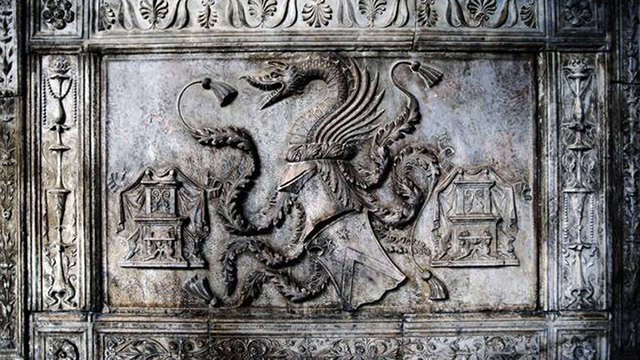According to “historians” cited by The Daily Mail (LOL!), you’re looking at the tomb of Vlad III, Prince of Wallachia, aka Vlad the Impaler, aka Dracula. Yes. The Dracula. The tomb is located in Santa Maria la Nova, in Naples, Italy. And they want to open it. It seems like the plot for a horror movie but, is it real?
Would they really find Dracula resting inside this beautifully sculpted grave?
The Estonian scholars cited by the Daily Mail claim that “new evidence” shows that Dracula didn’t die in a battle sometime between October 31 and December 31, 1476, as it was previously assumed. Most historians believe that Dracula was then killed on a road between Bucharest and Giurgiu, Romania, during an offensive to reconquer Wallachia from its pro-Ottoman Turk ruler Basarab Laiota. Most Romanian historians believe that Laiota beheaded Dracula, buried the body without ceremony, and sent the head as a trophy to Constantinople.
Later theories speculated that the body of the cruel Impaler that was the inspiration for Bram Stoker’s vampire novel, was buried near Bucharest, in the island monastery of Snagov, but most scholars think the body is in Comana — a monastery built by Vlad III himself that was demolished about one century later after his death.
The Italian connection theory
But now these researchers cited by the Mail claim this wasn’t the case. They believe that Dracula was made prisoner. His daughter Maria — who they say was sent to Naples before all this happened and married to a Neapolitan noble — paid the ransom and Dracula lived his last days in Italy (eating Italian virgins’ blood, no doubt.) When he died, they assert, he was buried in this church, which later became the resting place of his daughter and son-in-law.
Self-appointed medieval history scholar Raffaello Glinni believes that the Estonian researchers may be onto something. He claims that the tomb clearly shows the symbols of the House of Drăculești and not those of an Italian nobleman, which is what you would expect here:
When you look at the bas-relief sculptures, the symbolism is obvious. The dragon means Dracula and the two opposing sphinxes represent the city of Thebes, also known as Tepes. In these symbols, the very name of the count Dracula Tepes is written.
For those not into history, Romanian, or vampire lore, Dracula means son of Dracul. Vlad III’s father was Vlad II Dracul. Dracul means Dragon, a name his father had attached to his own because he was a member of the Order of the Dragon — ” a monarchical chivalric order for selected nobility, founded in 1408 by Sigismund, King of Hungary and later Holy Roman Emperor. It was fashioned after the military orders of the Crusades, requiring its initiates to defend the cross and fight the enemies of Christianity, in particular the Ottoman Turks.”
So, is it really his grave?
The idea of discovering the tomb of Vlad III in a church in Naples, Italy, is awesome — like the beginning of a movie starring Indiana Jones and Van Helsing. It’s also as believable as Spielberg and Stoker’s characters, as The BS Historian tells us in this post:
A dragon was certainly the main element in the badge of the Order of the Dragon to which Vlad III’s father belonged. We don’t actually know what Vlad III’s personal coat of arms was, but he may have used the same emblem. But this was a dragon curled around on itself with its own tail wrapped around its neck. The badge varied, but none of the extant Order dragon depictions resemble this Italian carving. The Thebes/Tepes connection seems to be entirely spurious; I can find nothing on it. The sphinxes are simply artistic convention in European art. Thebes itself is a Greek placename, Tepes a Turkish word for ‘impaler’. Where’s the connection? And why would anyone bother to ‘encode’ a vague reference to a member of the Dracul family. Either they wanted people to know he was buried there, in which case make it clear, or they wanted him forgotten, in which case don’t slap a dragon on his tomb. For that matter, it would be pretty tricky to build a huge monumental tomb, complete with effigy, for someone you’re keeping anonymous. But if Vlad’s daughter was amongst friends in Naples, with the Dragon Order connection, why would they use a generic dragon and not their proper symbol? Is the tomb even anonymous? I find it hard to believe that a splendid monumental tomb like that isn’t recorded as being that of a known Italian noble.
He also talks about Glinni, the “medieval scholar:”
Billed as a ‘medieval history scholar’ in the new article, Glinni is actually a lawyer by profession. His name took me to his site, which is sparse but getting there in terms of BS History Bingo. Knights Templar? Check. Freemasonry? Check. Da Vinci? You bet. Gibberings about non-specific magical vortices? Not looking too good. In fact it’s looking like the use of ‘secret history’ to support speculative archaeology. There is an historical document from 1531 indirectly referenced here, which is apparently cited in a 1958 book by D’Elia and Gelao. There’s even a page reference of p.289/290. The only D’Elia/Gelao book I can find is this from 1999, where Maria Balsa is indeed referenced. There’s no doubt that an historical figure of that name existed (wife of Giacomo Alfonso Ferrillo, Count of Muro and Acerenza), and she was apparently Slavic. But if this 1531 chronicle that supports not just this claim but the new tomb suggestion exists, I can find no reference to it. If any Italian speakers can unearth it, please comment below.
It all makes sense, but it is a bummer, really. I wanted it all to be true. I mean, to open Dracula’s freaking tomb! This guy, folks:

I rest my case.
I bet he would rise again and impale all the creators and actors of Twilight — plus all the writers and editors of The Daily Mail.
